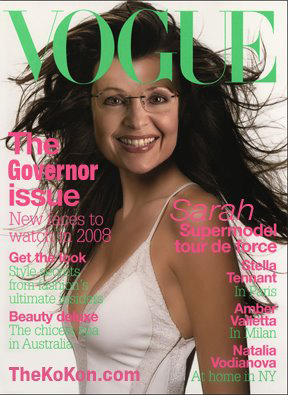 |
The first image is a photoshopped cover of Harper's Magazine, Bazaar from December 2007. It portrays Hillary Clinton in a cheetah print dress that is unbuttoned to the waist, to reveal fake cleavage. Directly to her left, there is the caption, "Look Fabulous at Every Age," and under that, there is a smaller subtitle, "Hillary's NEW LOOK for the Primaries." This fake cover attempts to sexualize Hillary Clinton -- a woman who has rarely had a fashion faux pas -- by deliberately enlarging her breast size. This magazine cover attempts to make fun of Clinton by making her breasts different sizes, perhaps to criticize her lack of sexual appeal in politics. As a woman, you can either conform to a man's world and play down your sexuality, which is what Hillary chose to do, or you can attempt to use your sexuality strategically to push males to accept females for who they are, instead of changing them. This picture just objectifies Hillary Clinton for not over-exposing her sexuality in her previous politics by claiming that this sexualized Hillary Clinton is the "New Look for the Primaries." |
| The other photoshopped image deals with Sarah Palin and places her on a Vouge fashion magazine cover. This photoshopped text is completely made up and is a model's body turned sideways with Sarah Palin's face placed over the model's. This magazine has text that reads "the Governor Issue" and "Sarah Supermodel." Here, Sarah Palin is portrayed in one of the most highly sexualized ways, as a fashion model. On the cover, her hair is blowing back in the wind and she is staring directly into the camera. Her gaze gives her a claim to power since it is direct and at eye level; however, the rest of the image demeans Palin's work as a politician by putting her in one of the most conforming positions, a model. This photoshopped cover has made her the subject, who is doing whatever the director tells them. Fashion models essentially are powerless because they are always told how to stand, what to wear, how to do their hair, and where they need to be. People think for them, which is essentially equating Sarah Palin to a person who cannot make her own decisions. As a politician, she is supposed to be strong willed and have a good head on her shoulders since she is in charge of making the best decision for her constituents, but as a fashion model, all of that is taken away from her. This image of Sarah Palin is arguably more sexualized than Hillary Clinton's, which is a reoccurring phenomenon that has taken place among all of these pictures, thus far. |

|
These magazine covers have demonstrated how there is a disparity between the way these two female politicians are seen, and between what they are expected to do. They are expected to be able to fit into a man's world and be strong and tough skinned, essentially, "There's no crying in baseball"-- or politics. On a daily basis, these women go about expressing their femininity in different ways. Palin is more likely to express her womanhood while Clinton is more reserved and always covers up or frequently wears pant suits. On Clinton's behalf, this was a common ideology, the idea that women would have to become like men in order to be taken seriously. Palin is slowly trying to break that binary by keeping her femininity and still working to be a strong, powerful, and respected figure in politics.